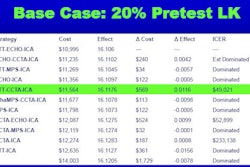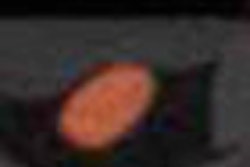Children admitted to emergency departments with acute periorbital swelling can be a challenge to diagnose. Specialists from Children's Hospital Boston used its hospital database of electronic medical records to create a risk model to try to give pediatric radiologists a better handle on when CT should or should not be used.
Acute periorbital swelling could be caused by preseptal cellulitis, a nonurgent condition. Or the patient may have orbital cellulitis or orbital abscess, which can cause blindness, intracranial infection, or death. CT scans facilitate rapid diagnosis, but how many children are unnecessarily exposed to this exam's high radiation dose?
Children's Hospital researchers used clinical predictors of subperiosteal, orbital, or intracranial complication in cases of acute periorbital swelling to identify children in high- and low-risk categories. The risk model, intended to stratify patients into groups that are most or least likely to have complications identified by CT scanning that would benefit from surgical intervention, is described in an article published in Pediatrics (2010, Vol. 125:4, pp. e719-e726).
The emergency department at Children's Hospital Boston admits approximately 50,000 patients each year. Emergency physicians have been using electronic notes since October 1995, and by September 2008, their database had more than 670,000 entries.
The database was electronically searched to identify otherwise healthy patients with acute periorbital edema and/or erythema who were believed to have preseptal cellulitis, orbital cellulitis, or intraorbital abscess, and 4,787 patients were identified. This number was reduced by more than half, to 1,912, when charts were manually reviewed. Ultimately, 918 patients met the study's eligibility criteria.
Thirty-two percent, or 298 children, had an orbital CT exam performed. Eighty percent of these patients also had subspecialty consultations, predominantly with ophthalmologists and otorhinolaryngologists.
Of the 298 patients, who ranged in age from 3 to nearly 10 years old, 111 had significant CT findings. More than half of this group, 56 patients, did not have ophthalmoplegia, proptosis, or pain with extraocular movements. These patients had had their symptoms for a median of two days.
A total of 469 patients were admitted to the hospital. Sixty-two patients had drainage of a subperiosteal or orbital abscess, and 10 had sinus surgery. Two patients lost their vision in the affected eye.
The research team, headed by Tiffany Rudloe, MD, an emergency physician, created a recursive partitioning model after statistically analyzing the data. Clinical findings of proptosis, ophthalmoplegia, or pain with extraocular movement represent high risk. Other stratification risk factors include a peripheral blood neutrophil count greater than 10,000/µL, significant periorbital edema, absence of infectious conjunctivitis, previous antibiotic therapy, and age greater than 3 years. Interestingly, the model did not identify fever as a predictor, and 44% of patients diagnosed with an abscess did not have one.
When applied to the 298 patients, the model correctly identified all high-risk patients, some 44%, as well as a low-risk group representing between three and eighteen patients. The model also did not identify any patients who had CT exams as being patients who did not need them.
Overall, when the model was used with the 918 patients who met the eligibility criteria, it categorized almost two-thirds as being low-risk patients and not needing emergent CT imaging. The model also did not identify any patients for whom CT exams should have been ordered.
Surprisingly, this tool for physicians has not yet been formally adopted at Children's Hospital Boston. When AuntMinnie.com inquired, Rudloe responded in an e-mail message that because the model has not yet been prospectively validated, it is not being routinely used. She advised that further studies are needed.
By Cynthia E. Keen
AuntMinnie.com staff writer
June 11, 2010
Related Reading
Algorithm could reduce cranial CT in minor pediatric head trauma, May 27, 2008
CT accurately diagnoses orbital inflammation arising from dental disease, April 5, 2006
US enables reliable diagnosis of pediatric orbital infections, December 30, 2002
Copyright © 2010 AuntMinnie.com




















